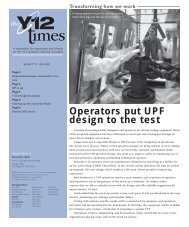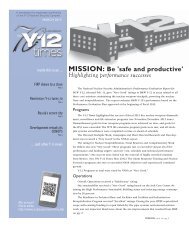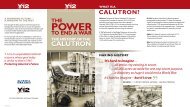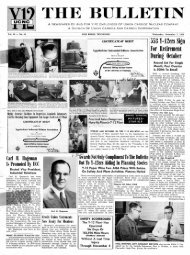A Biography of Dr. John M. Googin - Y-12 National Security ...
A Biography of Dr. John M. Googin - Y-12 National Security ...
A Biography of Dr. John M. Googin - Y-12 National Security ...
You also want an ePaper? Increase the reach of your titles
YUMPU automatically turns print PDFs into web optimized ePapers that Google loves.
FYI<br />
The major control instrument for all <strong>of</strong> this was<br />
the p(H) meter reading a grab sample. There were<br />
thermocouple reading controllers on the kilns. The<br />
levels in vessels and tanks could be taken with a dip<br />
stick.<br />
After all this education on security and process,<br />
the first day came to an end with a walking trip to<br />
the warehouse, at the same location as the present<br />
9720-6, with Ed to get the first batch <strong>of</strong> needed<br />
clothes. The walk was along the railroad siding that<br />
brought tank cars <strong>of</strong> chemicals to 9202.<br />
There had been considerable discussion along the<br />
way about the immediate objectives <strong>of</strong> the laboratory<br />
assigned to the Bulk Treatment operation. The<br />
plant needed to produce more and more as the new<br />
production buildings came on line. There was an<br />
expansion <strong>of</strong> Bulk Treatment underway, but it would<br />
be six months or more before we could finish it and<br />
the need was to make the present plant much more<br />
productive in the mean time.<br />
All <strong>of</strong> these discussions <strong>of</strong> the day had led to a<br />
conviction in the new recruit.<br />
On the way back from the warehouse with the<br />
clothes, the conversation turned to the near future<br />
and the new recruit told his new supervision that all<br />
<strong>of</strong> the evidence on hand to that time indicated to the<br />
new recruit that the immediate goals could be met. It<br />
was suggested that the recruit would be supervising<br />
his present supervisor within the next three months.<br />
FYI 38<br />
Chapter 3: A Y-<strong>12</strong> Junior Chemist’s 1944 Production<br />
Year. In the early weeks <strong>of</strong> 1944, Alpha-1 (9201-<br />
1) in Y-<strong>12</strong>, was being put on line as the first uranium<br />
isotope separation production process in the world.<br />
It did not really go too well. What had been a field by<br />
a stream in a poor valley a year and half before was<br />
now the center <strong>of</strong> a major industrial empire. The first<br />
<strong>of</strong> the buildings using a process, that many were<br />
saying would never work, was being placed in operation<br />
with great difficulty. The crew finally had to<br />
admit that the plant in its “as built” shape would not<br />
work because <strong>of</strong> electrical problems. It soon became<br />
apparent that much <strong>of</strong> the equipment connected to<br />
the cooling system for the units and the magnets<br />
would have to be disconnected, and the whole<br />
system systematically cleaned. The contamination in<br />
the systems would not allow the needed high voltages<br />
and stable currents. This was completed in<br />
another month and the building was restarted to<br />
continue in operation successfully until it was shut<br />
down in September 1945, after Hiroshima.<br />
When the author arrived in May 1944, the trauma<br />
<strong>of</strong> the start-up <strong>of</strong> the first building was over, and the<br />
subsequent buildings were rapidly coming on line.<br />
For the author, as a process development chemist in<br />
the Bulk Treatment Department in 9202, a problem<br />
that would continue was the processing <strong>of</strong> the flood<br />
<strong>of</strong> wash solutions from the Alpha buildings. We had<br />
to use the equipment at hand to recover the uranium<br />
as the pure oxide, and supply it to the Liquid<br />
Phase Department for the formation <strong>of</strong> the uranium<br />
pentachloride by reaction under pressure with<br />
carbon tetrachloride at elevated temperatures. The<br />
pentachloride went to Sublimation where it was<br />
decomposed and vaporized as the pure tetrachloride<br />
feed for the Calutrons.








